A fracking earthquake link has been identified by the Ohio Department of Natural Resources (ODNR), a finding that could have implications for oil & gas exploration and drilling within the state and the rest of the country.
ODNR Director, James Zehringer, announced new, stricter permit conditions for drilling close to areas of past seismic activity or faults. He added the new policies are in response to recent earth tremors in Poland Township, Mahoning County, that show a likely association with hydraulic fracturing near a known microfault.
In March, two earth tremors, the first with a magnitude of 3.0, were registered in Poland Township, seventy miles southeast of Cleveland. Drilling and fracking activities were suspended close to the site of the two earthquakes.
Hilcorp Energy was drilling near the site of the quakes last month. It cannot resume operations until regulators have received compelling evidence that drilling is safe.
Companies involved in horizontal drilling within three miles of an area of seismic activity or a known fault will have to install sensitive seismic monitors. Zehringer defined an area of seismic activity as one with a recorded tremor greater than 2.0 magnitude.
If a tremor higher than 1.0 magnitude is detected by those monitors, all activities will be suspended while the cause is investigated. If a probable association between the hydraulic fracturing process and the seismic event is determined, “all well completion operations will be suspended,” Zehringer said.

Hydraulic fracturing is stopped at the Hilcorp Energy drill site in Poland Township.
Fracking earthquake link triggers new permit criteria
In light of this new change in policy, ODNR announced it will develop new standards and permit conditions for new drilling applications. Permits that have already been issued in locations where drilling has not yet commenced will be reviewed, ODNR added.
Zehringer said:
“While we can never be 100 percent sure that drilling activities are connected to a seismic event, caution dictates that we take these new steps to protect human health, safety and the environment. Not only will this reasonable course of action help to ensure public health and safety but it will also help us to expand our underground maps and provide more information about all types of seismicity in Ohio.”
Gerry Baker, Associate Executive Director of the Interstate Oil and Gas Compact Commission (IOGCC), said:
“ODNR’s directives are a sensible response to a serious issue that regulators across the country are closely examining. IOGCC is pleased to work with Ohio and other states to share scientific data to better understand the nature of these occurrences.”
Executive Director of the Groundwater Protection Council, Mike Paque, welcomed ODNR’s change of policy. “State regulators are taking an aggressive lead in tackling tough and complicated oil and gas issues and ODNR is no exception,” Paque said.
16,000 hydraulic fracturing stages in Ohio so far
To date, over 800 wells have been drilled in the Utica and Marcellus shale play in the state of Ohio, including up to 16,000 hydraulic fracturing stages.
According to an investigation by ODNR geologists, the water and sand injected to the well during the hydraulic fracturing process may have placed excessive pressure on an unknown microfault in the area. “Further hydraulic fracturing at the site is suspended but the company will be permitted to recover resources from five of the previously drilled wells located on the pad. This is also expected to have the beneficial effect of reducing underground pressure and decreasing the likelihood of another seismic event,” ODNR wrote in a press release.
The state of Ohio has joined several other state regulators, under ODNR leadership, dedicated to learning more about the possible relationship between oil and gas activity and seismic activity. The consortium has detected 109 tremors greater than 2.0 magnitude.
In an interview with Reuters, Ray Beiersdorfer, professor of geology at Youngstown State University in Ohio, said “It is significant that they have acknowledged that there is a connection between fracking and earthquakes.”
ODNR had never linked earth tremors to fracking before. The agency believes that the new evidence gave it “reasonable certainty” that fracking caused the earthquakes.
Oklahoma registered a series of earth tremors last weekend. Seismologists, who forecast a record year for quake activity in the state, say they may be linked to oil and gas exploration.
